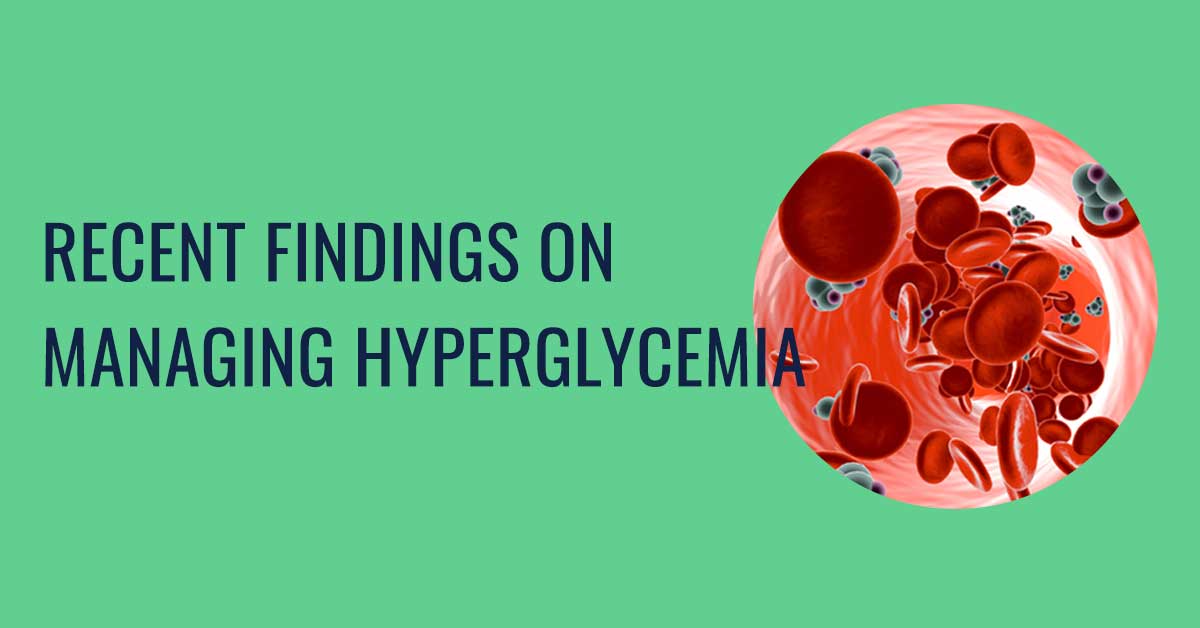Type 2 diabetes is a complicated, long-term (chronic) disease which severely affects the quality of life of patients suffering from it. Proper management of the disease calls for a comprehensive understanding of it as well as a multifaceted approach through behavioural and pharmacological treatments in order to prevent or mitigate complications that arise from it. Areas that need to be addressed include managing of weight, cardiovascular risk factors, comorbidities, and, of course, blood glucose levels. Furthermore, effective treatment plans must be organized and structured, taking into consideration social factors that affect health as well as patient preferences, to form individualised, person-centred strategies and targets.
Therefore, it is crucial that patients suffering from type 2 diabetes (T2D) have an understanding of the various aspects of diabetes care in order to achieve better treatment outcomes. In this article, we will take a look at some of the most recent findings on non-pharmacological principles of care for the management of hyperglycemia.
The Importance Of Glucose-lowering Treatments
Crucial aspects of type 2 diabetes management revolve around adopting healthy behaviours to reach recommended glycemic targets. These include medical nutrition therapy, physical activity, psychological support, and weight management.
Studies show that early interventions that help patients reach their glycemic targets produce significant and lasting results in reducing the risk of microvascular complications such as retinopathy, nephropathy, and neuropathy. Aside from their glucose-lowering effects, some pharmacological treatments such as GLP-1RA and SGLT2i have exhibited benefits for diabetes-related complications such as atherosclerotic cardiovascular disease, heart failure and chronic kidney disease.
Patients should note that since the benefits of glucose-lowering treatments emerge slowly while harm from comorbidities can be rapid or immediate, early intensive glycemic management is recommended.
Blood Glucose Levels
A healthy HbA1c target for (nonpregnant) adult type 2 diabetic patients to aim for is around 53 mmol/mol, which is 7% or less. If patients pay attention to hypoglycemia or other adverse effects from treatments, they can even reach lower HbA1c targets. In cases where short life expectancy, heightened complications or other intolerabilities are present, it is recommended to set higher glycemic targets.
The important takeaway is that your glycemic treatment goals must be customized to accommodate your condition as well as your preferences.
Use Of Language
As a patient living with type 2 diabetes, you must understand that language plays a crucial role in integrated care for the disease. You will benefit greatly by choosing caregivers who understand that language should be neutral, factual, respectful, inclusive, and free of stigma. Your caregivers must encourage collaboration and use a strength-based approach that focuses on what is working. Do not allow yourself to be referred to as “a diabetic” or “non-compliant”, and never blame yourself for your health condition.
Diabetes Self-management Education And Support (DSMES)
Studies show that DSMES is almost as important as the selection of your treatment plan when it comes to managing type 2 diabetes. Ample evidence suggests that DSMES will improve your knowledge regarding glycemic management and, as a result, your glycemic levels, as well as clinical and psychological results. It can even reduce your hospital admissions and improve your mortality rate and is highly cost-effective.
Due to the constantly changing nature of type 2 diabetes, it is crucial that you receive DSMES on an ongoing basis, offered face-to-face in a group or individual setting. Always ensure that your educators are well-trained and updated. You should focus on receiving DSMES at stages such as diagnosis, the arising of complications, transitions in life and treatment, and optimally on an annual basis.
A comprehensive DSMES program should cover lifestyle behaviours such as healthy eating, physical activity and weight management, medication-taking behaviour, self-monitoring, self-efficacy, coping and problem-solving. Make it a point to talk to your educator if you feel that you are not confident in any of these areas. Furthermore, your DSMES should be specific to your situation, including your beliefs and choices.
Always remember that DSMES is not a substitute for any mental health services that you may require. Psychiatric disorders such as erratic eating behaviours must be handled by relevant professionals as such conditions contribute to poor outcomes in diabetes treatments.
Weight Reduction
Weight loss plays a crucial role in type 2 diabetes treatment that goes beyond glycemic management. Not only does it improve HbA1c, but it also reduces the risk of comorbidities, leading to an increased quality of life.
The primary weight loss target for type 2 diabetes patients should be around 5-15%. Needless to say, higher weight loss results translate to better outcomes. Metabolic improvements can be achieved through 5-10% weight loss. With 10-15% or higher weight loss, remission of diabetes is a possible outcome.
Blood Glucose Monitoring
For patients taking insulin, regular blood glucose monitoring plays a crucial role in self-management and medication adjustment.
Although regular blood glucose monitoring can be an additional burden and cost for patients who do not use insulin, it can provide useful insights into lifestyle and medication management.
Treatment Behaviours
Many patients with type 2 diabetes (almost half) are affected by suboptimal medication-taking behaviours and low rates of continued medication use. This is an unfortunate occurrence which leads to poor results in glycemic and cardiovascular disease risk factor control. Severe repercussions of this behaviour include a heightened risk of diabetes complications, increased hospital admissions, healthcare costs, and mortality rates.
Therefore, it is important to understand which factors contribute to irregular use or discontinuation of medication/ treatments. These factors include:
- Perceived lack of medication efficacy,
- Fear of hypoglycemia,
- Lack of access to medication, and
- Adverse effects of medication
The way to overcome this behaviour is by focusing on facilitators of adherence. These include:
- Support from society/ family/ provider
- Motivation
- Education
- Access to medication and food
Therapeutic Inertia
Therapeutic inertia is the failure of treatment modification, either when your glycemic management goals are not met or when you are overtreated. You can play an active role in avoiding therapeutic inertia by engaging multidisciplinary teams in your treatment plan.
Stages of decision-making for a comprehensive, person-centred glycemic management plan
- Assess key personal characteristics
- Consider specific factors that impact the choice of treatment
- Utilise shared decision-making to create a management plan
- Agree on a management plan
- Implement management plan
- Receive ongoing support and monitoring
- Review and agree on management plan
Lifestyle And Behavioural Changing Therapeutic Options For Managing Hyperglycemia
Nutrition Therapy
Nutrition therapy plays an important role in managing type 2 diabetes. Goals of nutrition therapy include:
- Promoting and supporting healthy eating patterns
- Addressing individual nutrition requirements
- Maintaining the pleasure of eating
- Providing patients with tools for developing healthy eating patterns.
When provided by a registered dietitian/ nutritionist, nutrition therapy can complement DSMES and reduce blood glucose and prevent/ delay comorbidities.
The core aspects of nutrition therapy are dietary quality and energy restriction.
Dietary Quality
Dietary quality does not necessarily mean a standard, optimal ratio of carbohydrate, protein, and fat intake. Rather, it denotes an individually selected eating pattern specific to each patient. Dietary quality does, however, emphasize foods with proven health benefits while minimising/ avoiding foods that have been proven to be detrimental or harmful. It is important that new healthy dietary habits are feasible as well as sustainable.
Studies have shown that low-carb, Mediterranean, vegetarian, and vegan are some of the diets that yield the highest results in managing weight and HbA1c levels, effectively delaying the need for diabetes medication and also improving cardiovascular health.
Energy Restriction
Any healthy eating plan with glycemic and weight management goals would result in an energy deficit. Furthermore, the ability to maintain this net energy deficit over a period of time is crucial for weight loss.
Physical Activity Behaviours
Physical activity behaviours or physical behaviours have a high impact on cardiometabolic health in type 2 diabetes patients.
Your main targets in a physical activity regimen should be reaching fixed goals of physical activity duration and reducing sedentary time.
Aerobic Exercises (Moderate-vigorous Activity)
Regular aerobic exercises that involve rhythmic engagement of large muscle groups have been shown to be highly effective in glycemic management as well as in improving cardiorespiratory fitness.
You are encouraged to engage in a minimum of 150 minutes of moderately intense aerobic activities or a minimum of 75 minutes of vigorously intense aerobic activities per week, spread over 3 or more days, with no more than 2 consecutive days of inactivity for best results.
Results can be enhanced if these activities are carried out after meals, ideally in 45-minute sessions.
Even 30 minutes of moderate-intensity aerobic activity per week can improve metabolic profiles.
Resistance Exercises
Resistance exercises that use your own body weight or work as resistance can improve blood glucose levels and insulin sensitivity. They also improve flexibility and balance, which is highly beneficial because type 2 diabetes is associated with an increased risk of impaired physical functioning. Exercises like Tai Chi and Yoga are especially helpful in improving flexibility and balance.
Stepping
You might be surprised to know that just 5 to 6 minutes of brisk-intensity walking on a daily basis can improve life expectancy by almost 4 years in type 2 diabetes patients. Increasing your daily number of steps by 500 can result in a 2-9% decrease in the risk of cardiovascular morbidities as well as all-cause mortality.
Avoiding Prolonged Sitting
Apart from physical activities, you should also focus on limiting your time spent sitting down. Breaking up sedentary/ sitting time with 5 minutes of slow walking or simple resistance training every half an hour will lead to improved glucose metabolism.
Sleep
Sleeping disorders such as sleep apnea affect more than half of type 2 diabetes patients. Studies have proven that sleep disorders are associated with a high risk of obesity, impaired daytime functioning and glucose metabolism. Therefore, healthy sleeping patterns play a crucial role in managing type 2 diabetes.
Quantity
Duration of sleep should be between 6-8 hours. Anything below or above that range can negatively impact glycemic levels.
Quality
Goals should be set to achieve regular sleeping patterns. Irregularities in sleeping patterns result in suboptimal glycemic levels.
Chronotype
People who go to bed late and get up late are more prone to inactivity and poor glycemic levels than those who go to bed early and get up early. However, the evidence for this is not very strong.
Metabolic Surgery: A Surgical Solution For Weight Management
For the last few decades, a variety of surgical options have been available for the treatment of morbid obesity. Although the efficacy may vary with the type of surgery, metabolic or bariatric surgeries have been shown to produce results in managing type 2 diabetes along with weight loss. However, patients need to meet eligibility criteria to be suitable for surgical intervention.
Healthy Weight Australia offers a variety of bariatric surgery options for people struggling to achieve satisfactory results in weight loss. Follow the link to find out more about our surgical programs or to book a consultation.










